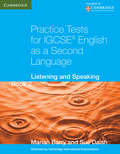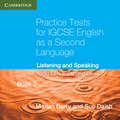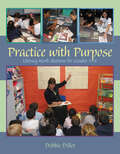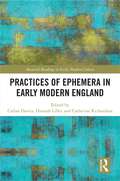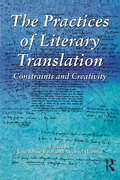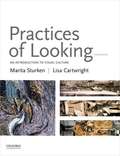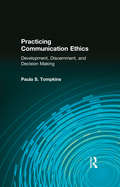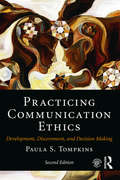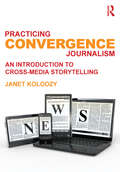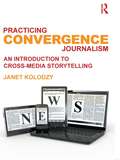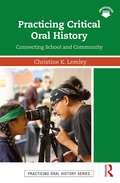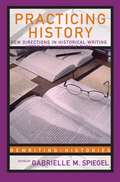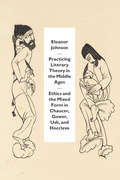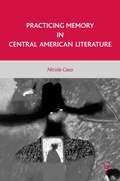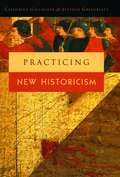- Table View
- List View
Practice Tests for IGCSE® English as a Second Language Book 2: Listening and Speaking (PDF)
by Marian Barry Sue DaishThe tests will help familiarise students with the format and requirements of the Reading and Writing/Listening and Speaking papers. This book contains exam-format practice tests for Papers 4 and 5 of the Cambridge IGCSE in English as a Second Language. It includes four Extended-level listening practice tests and twenty oral (speaking) test tasks. The tests will help build confidence and develop exam techniques by familiarising students with the format of the Listening and Oral papers, and with the kinds of topics and exercises they will encounter. The material is also suitable for non-exam students at intermediate to upper-intermediate level, particularly those preparing for academic study.
Practice Tests for IGCSE English as a Second Language Book 2 (Extended Level): Listening and Speaking (PDF)
by Marian Barry Sue DaishThe tests will help familiarise students with the format and requirements of the Reading and Writing/Listening and Speaking papers. These Audio CDs contain content endorsed by University of Cambridge International Examinations and are for the Extended level of the Cambridge IGCSE in English as a Second Language. Designed to be used alongside Listening and Speaking Book 2, the listening tests give practice in identifying specific information, completing skeletal notes and understanding more complex meanings, opinions and attitudes.
Practice with Purpose: Literacy Work Stations for Grades 3-6
by Debbie DillerIn her 30 years as an educator, Debbie Diller has closely examined classroom practice, asking Why? What's the purpose? Watching primary students work successfully at literacy work stations, she wondered with teachers, Why don't we have upper-grade students doing this? Could we kick it up a notch? In her new book, Debbie shows teachers of grades three-to-six how to structure their classrooms so that all students can be successful doing meaningful independent work using literacy work stations. Practice with Purpose offers guidance on establishing routines for independent reading and response writing, as well as step-by-step instructions on how to set up and manage a variety of hands-on literacy work stations appropriate for intermediate students. Each chapter includes: how to introduce the station;innovative ways to use materials;what to model to guarantee independence;how to troubleshoot; assessment and accountability ideas; how the station supports student achievement on state tests; reflection questions for professional development. The extensive appendix includes time-saving tools such as management board icons, graphic organizers, task cards, and recommended Web sites and children's literature.
Practice with Purpose: Literacy Work Stations for Grades 3-6
by Debbie DillerIn her 30 years as an educator, Debbie Diller has closely examined classroom practice, asking Why? What's the purpose? Watching primary students work successfully at literacy work stations, she wondered with teachers, Why don't we have upper-grade students doing this? Could we kick it up a notch? In her new book, Debbie shows teachers of grades three-to-six how to structure their classrooms so that all students can be successful doing meaningful independent work using literacy work stations. Practice with Purpose offers guidance on establishing routines for independent reading and response writing, as well as step-by-step instructions on how to set up and manage a variety of hands-on literacy work stations appropriate for intermediate students. Each chapter includes: how to introduce the station;innovative ways to use materials;what to model to guarantee independence;how to troubleshoot; assessment and accountability ideas; how the station supports student achievement on state tests; reflection questions for professional development. The extensive appendix includes time-saving tools such as management board icons, graphic organizers, task cards, and recommended Web sites and children's literature.
Practices of Ephemera in Early Modern England (Material Readings in Early Modern Culture)
by Callan Davies Hannah Lilley Catherine RichardsonThis collection is the first to historicise the term ephemera and its meanings for early modern England and considers its relationship to time, matter, and place. It asks: how do we conceive of ephemera in a period before it was routinely employed (from the eighteenth century) to describe ostensibly disposable print? In the sixteenth and seventeenth centuries—when objects and texts were rapidly proliferating—the term began to acquire its modern association with transitoriness. But contributors to this volume show how ephemera was also integrally related to wider social and cultural ecosystems. Chapters explore those ecosystems and think about the papers and artefacts that shaped homes, streets, and cities or towns and their attendant preservation, loss, or transformation. The studies here therefore look beyond static records to think about moments of process and transmutation and accordingly get closer to early modern experiences, identities, and practices.
Practices of Ephemera in Early Modern England (Material Readings in Early Modern Culture)
by Callan Davies Hannah Lilley Catherine RichardsonThis collection is the first to historicise the term ephemera and its meanings for early modern England and considers its relationship to time, matter, and place. It asks: how do we conceive of ephemera in a period before it was routinely employed (from the eighteenth century) to describe ostensibly disposable print? In the sixteenth and seventeenth centuries—when objects and texts were rapidly proliferating—the term began to acquire its modern association with transitoriness. But contributors to this volume show how ephemera was also integrally related to wider social and cultural ecosystems. Chapters explore those ecosystems and think about the papers and artefacts that shaped homes, streets, and cities or towns and their attendant preservation, loss, or transformation. The studies here therefore look beyond static records to think about moments of process and transmutation and accordingly get closer to early modern experiences, identities, and practices.
The Practices of Literary Translation: Constraints and Creativity
by Jean Boase-Beier Michael HolmanIn their introduction to this collection of essays, the editors argue that constraints can be seen as a source of literary creativity, and given that translation is even more constrained than 'original' literary production, it thus has the potential to be even more creative too. The ten essays that follow outline ways in which translators and translations are constrained by poetic form, personal histories, state control, public morality, and the non-availability of comparable target language subcodes, and how translator creativity may-or may not-overcome these constraints. Topics covered are: Baudelaire's translation practices; bowdlerism in translations of Voltaire, Boccaccio and Shakespeare, among others; Leyris's translations of Gerard Manley Hopkins; ideology in English-Arabic translation; the translation of censored Greek poet Rhea Galanaki; theatre translation; Nabokov and translation; gay translation; Moratín's translation of Hamlet; and state control of translation production in Nazi Germany. The essays are mostly highly readable, and often entertaining.
The Practices of Literary Translation: Constraints and Creativity
by Jean Boase-Beier Michael HolmanIn their introduction to this collection of essays, the editors argue that constraints can be seen as a source of literary creativity, and given that translation is even more constrained than 'original' literary production, it thus has the potential to be even more creative too. The ten essays that follow outline ways in which translators and translations are constrained by poetic form, personal histories, state control, public morality, and the non-availability of comparable target language subcodes, and how translator creativity may-or may not-overcome these constraints. Topics covered are: Baudelaire's translation practices; bowdlerism in translations of Voltaire, Boccaccio and Shakespeare, among others; Leyris's translations of Gerard Manley Hopkins; ideology in English-Arabic translation; the translation of censored Greek poet Rhea Galanaki; theatre translation; Nabokov and translation; gay translation; Moratín's translation of Hamlet; and state control of translation production in Nazi Germany. The essays are mostly highly readable, and often entertaining.
Practices Of Looking: An Introduction To Visual Culture
by Marita Sturken Lisa CartwrightPractices of Looking, Third Edition, bridges visual, communication, media, and cultural studies to investigate how images and the activity of looking carry meaning within and between different arenas in everyday life. The third edition has been updated to represent the contemporary visual cultural landscape and includes topics like the increasingly rapid global circulation of media, the rise of design and DIY cultures, digital media art and activism, and challenges to photojournalism and news media. Challenging yet accessible, Practices of Looking, Third Edition, is ideal for courses across a range of disciplines.
Practicing Communication Ethics: Development, Discernment, and Decision-Making
by Kenneth E. Anderson Paula S. TompkinsPracticing Communication Ethics provides a theoretical framework for developing a personal standard of ethics that can be applied in real world communication situations. Through an examination of specific ethical values including truth, justice, freedom, care, and integrity, this first edition enables the reader to personally determine which values they are ethically committed to upholding. Blending communication theory, ethics as practical philosophy, and moral psychology, this text presents the practice of communication ethics as part of the lifelong process of personal development and fosters the ability in its readers to approach communication decision-making through an ethical lens.
Practicing Communication Ethics: Development, Discernment, and Decision-Making
by Kenneth E. Anderson Paula S. TompkinsPracticing Communication Ethics provides a theoretical framework for developing a personal standard of ethics that can be applied in real world communication situations. Through an examination of specific ethical values including truth, justice, freedom, care, and integrity, this first edition enables the reader to personally determine which values they are ethically committed to upholding. Blending communication theory, ethics as practical philosophy, and moral psychology, this text presents the practice of communication ethics as part of the lifelong process of personal development and fosters the ability in its readers to approach communication decision-making through an ethical lens.
Practicing Communication Ethics: Development, Discernment, and Decision Making
by Paula S. TompkinsPracticing Communication Ethics: Development, Discernment, and Decision Making presents a theoretical framework for developing a personal standard of ethics that can be applied in everyday communication situations. This second edition focuses on how the reader’s communication matters ethically in cocreating their relationships, family, workgroups, and communities. Through an examination of ethical values including truth, justice, freedom, care, integrity, and honor, the reader can determine which values they are ethically committed to upholding. Blending communication theory, ethics as practical philosophy, and moral psychology, the text presents the practice of communication ethics as part of the lifelong process of personal development and fosters the ability in its readers to approach communication decision making through an ethical lens.
Practicing Communication Ethics: Development, Discernment, and Decision Making
by Paula S. TompkinsPracticing Communication Ethics: Development, Discernment, and Decision Making presents a theoretical framework for developing a personal standard of ethics that can be applied in everyday communication situations. This second edition focuses on how the reader’s communication matters ethically in cocreating their relationships, family, workgroups, and communities. Through an examination of ethical values including truth, justice, freedom, care, integrity, and honor, the reader can determine which values they are ethically committed to upholding. Blending communication theory, ethics as practical philosophy, and moral psychology, the text presents the practice of communication ethics as part of the lifelong process of personal development and fosters the ability in its readers to approach communication decision making through an ethical lens.
Practicing Convergence Journalism: An Introduction to Cross-Media Storytelling
by Janet KolodzyPracticing Convergence Journalism teaches budding journalists how to make the most of digital technology to tell their stories effectively across multiple media platforms—in print, audio, video and online. Janet Kolodzy addresses multi-media and cross-media thinking, organizing, reporting and producing for both short-form spot news and long-form features. Her approach focuses on storytelling principles, not just specific technical practices, providing journalists with the mindset and skills they need to adapt their writing and reporting for the tools of today and tomorrow. With this book and the aid of its companion website, students learn how to: Develop a cross-media mode of journalistic thinking that will result in stories suitable for a fast-paced, multitasking and mobile audience. Decide when visuals are useful and necessary, and understand how to capture, select and organize them to effectively enhance a reader’s understanding of a story. Put together various elements of storytelling (writing, audio, moving and still pictures) for an interactive journalistic experience.
Practicing Convergence Journalism: An Introduction to Cross-Media Storytelling
by Janet KolodzyPracticing Convergence Journalism teaches budding journalists how to make the most of digital technology to tell their stories effectively across multiple media platforms—in print, audio, video and online. Janet Kolodzy addresses multi-media and cross-media thinking, organizing, reporting and producing for both short-form spot news and long-form features. Her approach focuses on storytelling principles, not just specific technical practices, providing journalists with the mindset and skills they need to adapt their writing and reporting for the tools of today and tomorrow. With this book and the aid of its companion website, students learn how to: Develop a cross-media mode of journalistic thinking that will result in stories suitable for a fast-paced, multitasking and mobile audience. Decide when visuals are useful and necessary, and understand how to capture, select and organize them to effectively enhance a reader’s understanding of a story. Put together various elements of storytelling (writing, audio, moving and still pictures) for an interactive journalistic experience.
Practicing Critical Oral History: Connecting School and Community (Practicing Oral History)
by Christine K. LemleyPracticing Critical Oral History: Connecting School and Community provides ways and words for educators to use critical oral history in their classroom and communities in order to put their students and the voices of people from marginalized communities at the center of their curriculum to enact change. Clearly and concisely written, this book offers a thought-provoking overview of how to use stories from those who have been underrepresented by dominant systems to identify a critical topic, engage with critical processes, and enact critical transformative-justice outcomes. Critical oral history both writes and rights history, so that participants—both interviewers and narrators—in critical oral history projects aim to contextualize stories and make the voices and perspectives of those who have been historically marginalized heard and listened to. Supplemented throughout with sample activities, lesson-plan outlines, tables, and illustrative figures, Practicing Critical Oral History: Connecting School and Community is an essential resource for all those interested in integrating the techniques of critical oral history into an educational setting.
Practicing Critical Oral History: Connecting School and Community (Practicing Oral History)
by Christine K. LemleyPracticing Critical Oral History: Connecting School and Community provides ways and words for educators to use critical oral history in their classroom and communities in order to put their students and the voices of people from marginalized communities at the center of their curriculum to enact change. Clearly and concisely written, this book offers a thought-provoking overview of how to use stories from those who have been underrepresented by dominant systems to identify a critical topic, engage with critical processes, and enact critical transformative-justice outcomes. Critical oral history both writes and rights history, so that participants—both interviewers and narrators—in critical oral history projects aim to contextualize stories and make the voices and perspectives of those who have been historically marginalized heard and listened to. Supplemented throughout with sample activities, lesson-plan outlines, tables, and illustrative figures, Practicing Critical Oral History: Connecting School and Community is an essential resource for all those interested in integrating the techniques of critical oral history into an educational setting.
Practicing History: New Directions in Historical Writing after the Linguistic Turn (Rewriting Histories)
by Gabrielle M. SpiegelThis essential collection of key articles offers a re-evaluation of the practice of history in light of current debates. Critical thinkers and practicing historians present their writings, along with clear and thorough editorial material, to examine the complex ideas at the forefront of historical practice. This volume gives a synoptic overview of the last twenty-five years’ theoretical analysis of historical writing, with a critical examination of the central concepts and positions that have been in debate. The collection delineates the emergence of "practice theory" as a possible paradigm for future historical interpretation concerned with questions of agency, experience and the subject. These complex ideas are introduced to students in this accessible reader, and for teachers and historians too, this survey is an indispensable and timely read.
Practicing History: New Directions in Historical Writing after the Linguistic Turn (Rewriting Histories)
by Gabrielle M. SpiegelThis essential collection of key articles offers a re-evaluation of the practice of history in light of current debates. Critical thinkers and practicing historians present their writings, along with clear and thorough editorial material, to examine the complex ideas at the forefront of historical practice. This volume gives a synoptic overview of the last twenty-five years’ theoretical analysis of historical writing, with a critical examination of the central concepts and positions that have been in debate. The collection delineates the emergence of "practice theory" as a possible paradigm for future historical interpretation concerned with questions of agency, experience and the subject. These complex ideas are introduced to students in this accessible reader, and for teachers and historians too, this survey is an indispensable and timely read.
Practicing Literary Theory in the Middle Ages: Ethics and the Mixed Form in Chaucer, Gower, Usk, and Hoccleve
by Eleanor JohnsonLiterary scholars often avoid the category of the aesthetic in discussions of ethics, believing that purely aesthetic judgments can vitiate analyses of a literary work’s sociopolitical heft and meaning. In Practicing Literary Theory in the Middle Ages, Eleanor Johnson reveals that aesthetics—the formal aspects of literary language that make it sense-perceptible—are indeed inextricable from ethics in the writing of medieval literature. Johnson brings a keen formalist eye to bear on the prosimetric form: the mixing of prose with lyrical poetry. This form descends from the writings of the sixth-century Christian philosopher Boethius—specifically his famous prison text, Consolation of Philosophy—to the late medieval English tradition. Johnson argues that Boethius’s text had a broad influence not simply on the thematic and philosophical content of subsequent literary writing, but also on the specific aesthetic construction of several vernacular traditions. She demonstrates the underlying prosimetric structures in a variety of Middle English texts—including Chaucer’s Troilus and Criseyde and portions of the Canterbury Tales, Thomas Usk’s Testament of Love, John Gower’s Confessio amantis, and Thomas Hoccleve’s autobiographical poetry—and asks how particular formal choices work, how they resonate with medieval literary-theoretical ideas, and how particular poems and prose works mediate the tricky business of modeling ethical transformation for a readership.
Practicing Literary Theory in the Middle Ages: Ethics and the Mixed Form in Chaucer, Gower, Usk, and Hoccleve
by Eleanor JohnsonLiterary scholars often avoid the category of the aesthetic in discussions of ethics, believing that purely aesthetic judgments can vitiate analyses of a literary work’s sociopolitical heft and meaning. In Practicing Literary Theory in the Middle Ages, Eleanor Johnson reveals that aesthetics—the formal aspects of literary language that make it sense-perceptible—are indeed inextricable from ethics in the writing of medieval literature. Johnson brings a keen formalist eye to bear on the prosimetric form: the mixing of prose with lyrical poetry. This form descends from the writings of the sixth-century Christian philosopher Boethius—specifically his famous prison text, Consolation of Philosophy—to the late medieval English tradition. Johnson argues that Boethius’s text had a broad influence not simply on the thematic and philosophical content of subsequent literary writing, but also on the specific aesthetic construction of several vernacular traditions. She demonstrates the underlying prosimetric structures in a variety of Middle English texts—including Chaucer’s Troilus and Criseyde and portions of the Canterbury Tales, Thomas Usk’s Testament of Love, John Gower’s Confessio amantis, and Thomas Hoccleve’s autobiographical poetry—and asks how particular formal choices work, how they resonate with medieval literary-theoretical ideas, and how particular poems and prose works mediate the tricky business of modeling ethical transformation for a readership.
Practicing Literary Theory in the Middle Ages: Ethics and the Mixed Form in Chaucer, Gower, Usk, and Hoccleve
by Eleanor JohnsonLiterary scholars often avoid the category of the aesthetic in discussions of ethics, believing that purely aesthetic judgments can vitiate analyses of a literary work’s sociopolitical heft and meaning. In Practicing Literary Theory in the Middle Ages, Eleanor Johnson reveals that aesthetics—the formal aspects of literary language that make it sense-perceptible—are indeed inextricable from ethics in the writing of medieval literature. Johnson brings a keen formalist eye to bear on the prosimetric form: the mixing of prose with lyrical poetry. This form descends from the writings of the sixth-century Christian philosopher Boethius—specifically his famous prison text, Consolation of Philosophy—to the late medieval English tradition. Johnson argues that Boethius’s text had a broad influence not simply on the thematic and philosophical content of subsequent literary writing, but also on the specific aesthetic construction of several vernacular traditions. She demonstrates the underlying prosimetric structures in a variety of Middle English texts—including Chaucer’s Troilus and Criseyde and portions of the Canterbury Tales, Thomas Usk’s Testament of Love, John Gower’s Confessio amantis, and Thomas Hoccleve’s autobiographical poetry—and asks how particular formal choices work, how they resonate with medieval literary-theoretical ideas, and how particular poems and prose works mediate the tricky business of modeling ethical transformation for a readership.
Practicing Memory in Central American Literature
by N. CasoThrough penetrating analysis of twentieth-century historical fiction from Central America this book asks: why do so many literary texts in the region address historical issues? What kinds of stories are told about the past when authors choose the fictional realm to represent history? Why access memory through fiction and poetry? Nicole Caso traces the active interplay between language, space, and memory in the continuous process of defining local identities through literature. Ultimately, this book looks to the dynamic between form and content to identify potential maps that are suggested in each of these texts in order to imagine possibilities of action in the future.
Practicing New Historicism
by Catherine Gallagher Stephen GreenblattFor almost twenty years, new historicism has been a highly controversial and influential force in literary and cultural studies. In Practicing the New Historicism, two of its most distinguished practitioners reflect on its surprisingly disparate sources and far-reaching effects. In lucid and jargon-free prose, Catherine Gallagher and Stephen Greenblatt focus on five central aspects of new historicism: recurrent use of anecdotes, preoccupation with the nature of representations, fascination with the history of the body, sharp focus on neglected details, and skeptical analysis of ideology. Arguing that new historicism has always been more a passionately engaged practice of questioning and analysis than an abstract theory, Gallagher and Greenblatt demonstrate this practice in a series of characteristically dazzling readings of works ranging from paintings by Joos van Gent and Paolo Uccello to Hamlet and Great Expectations. By juxtaposing analyses of Renaissance and nineteenth-century topics, the authors uncover a number of unexpected contrasts and connections between the two periods. Are aspects of the dispute over the Roman Catholic doctrine of the Eucharist detectable in British political economists' hostility to the potato? How does Pip's isolation in Great Expectations shed light on Hamlet's doubt? Offering not only an insider's view of new historicism, but also a lively dialogue between a Renaissance scholar and a Victorianist, Practicing the New Historicism is an illuminating and unpredictable performance by two of America's most respected literary scholars. "Gallagher and Greenblatt offer a brilliant introduction to new historicism. In their hands, difficult ideas become coherent and accessible."—Choice "A tour de force of new literary criticism. . . . Gallagher and Greenblatt's virtuoso readings of paintings, potatoes (yes, spuds), religious ritual, and novels—all 'texts'—as well as essays on criticism and the significance of anecdotes, are likely to take their place as model examples of the qualities of the new critical school that they lead. . . . A zesty work for those already initiated into the incestuous world of contemporary literary criticism-and for those who might like to see what all the fuss is about."—Kirkus Reviews, starred review
Practicing New Historicism
by Catherine Gallagher Stephen GreenblattFor almost twenty years, new historicism has been a highly controversial and influential force in literary and cultural studies. In Practicing the New Historicism, two of its most distinguished practitioners reflect on its surprisingly disparate sources and far-reaching effects. In lucid and jargon-free prose, Catherine Gallagher and Stephen Greenblatt focus on five central aspects of new historicism: recurrent use of anecdotes, preoccupation with the nature of representations, fascination with the history of the body, sharp focus on neglected details, and skeptical analysis of ideology. Arguing that new historicism has always been more a passionately engaged practice of questioning and analysis than an abstract theory, Gallagher and Greenblatt demonstrate this practice in a series of characteristically dazzling readings of works ranging from paintings by Joos van Gent and Paolo Uccello to Hamlet and Great Expectations. By juxtaposing analyses of Renaissance and nineteenth-century topics, the authors uncover a number of unexpected contrasts and connections between the two periods. Are aspects of the dispute over the Roman Catholic doctrine of the Eucharist detectable in British political economists' hostility to the potato? How does Pip's isolation in Great Expectations shed light on Hamlet's doubt? Offering not only an insider's view of new historicism, but also a lively dialogue between a Renaissance scholar and a Victorianist, Practicing the New Historicism is an illuminating and unpredictable performance by two of America's most respected literary scholars. "Gallagher and Greenblatt offer a brilliant introduction to new historicism. In their hands, difficult ideas become coherent and accessible."—Choice "A tour de force of new literary criticism. . . . Gallagher and Greenblatt's virtuoso readings of paintings, potatoes (yes, spuds), religious ritual, and novels—all 'texts'—as well as essays on criticism and the significance of anecdotes, are likely to take their place as model examples of the qualities of the new critical school that they lead. . . . A zesty work for those already initiated into the incestuous world of contemporary literary criticism-and for those who might like to see what all the fuss is about."—Kirkus Reviews, starred review
